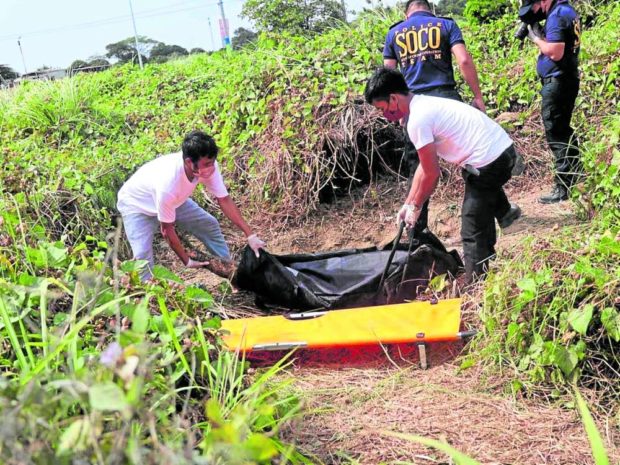17 face raps in Adamson student’s hazing death

‘WASTED DREAMS’ | His family describes Adamson University chemistry junior John Matthew Salilig as the “brainiest” among seven siblings. On Tuesday, his body was found in a shallow grave in Imus, Cavite, days after attending Tau Gamma Phi’s initiation rites in Biñan City. (Photo from the Cavite Police Provincial Office)
MANILA, Philippines — John Matthew Salilig, 24, was a jolly person “who never ran out of jokes” and was “always the life of the party,” but underneath his cheerful exterior was a young man with big dreams, his grieving family said on Wednesday.
The youngest and “brainiest” among seven siblings, Salilig originally wanted to be a pilot but shifted to chemistry in hopes of helping the country improve its oil refining capacity, “so Filipinos can enjoy better and affordable fuel,” said his eldest brother, John Michael.
“But all his dreams were gone and wasted just because of this brotherhood,” Salilig’s other brother, John Martin, said.
On Tuesday, the battered naked body of the Adamson University student was found in a shallow grave in Imus, Cavite province, days after he attended the “welcoming rites” of Tau Gamma Phi, the fraternity now at the center of the police invesitgation into the fatal hazing.
Police on Wednesday said they were preparing to file criminal charges against 17 Tau Gamma members based on witness testimonies, including Salilig’s fellow recruit in the fraternity.
Article continues after this advertisement
Photo from Salilig family
Held for obstruction
The Biñan City police chief, Lt. Col. Virgilio Jopia, said at least four witnesses from the fraternity had admitted that Salilig underwent initiation rites with Tau Gamma on Feb. 18.
Article continues after this advertisementIn a phone interview with the Inquirer, Jopia said 17 persons of interest were named by one witness.
Seven people who allegedly took part in the initiation were held in the Biñan police station for questioning, while another man — the father of one of the persons of interest — was detained for obstruction of justice.
According to Jopia, the persons of interest were able to give detailed accounts of what happened at the gathering.
“During the initiation rites, there were already signs that the victim was already having a hard time…. According to a witness, by 3 p.m. of Feb. 18 he was already vomiting,” Jopias said. “But [on the way] back to Manila, he already passed away.”
The official surmised that the fraternity members panicked and decided to bury the body “out of fear.”
According to John Michael, Salilig was last seen alive boarding a bus headed for Biñan with his fraternity brothers — or “brods”— at a bus terminal in Pasay City on Feb. 17.
He said he had allowed his brother to attend the activity, believing he would not be harmed, a decision he now deeply regretted.
Salilig’s body bore signs of severe beating when found on Tuesday in Imus.
He was whacked with a paddle at least 70 times, investigators said, quoting the statements of witnesses.
Salilig’s father Jeofrrey said his son was naked when his body was found.

HASTY DETOUR | Investigators say the vehicle pictured here might have been used to transport alleged hazing victim John Matthew Salilig from the site of Tau Gamma Phi’s welcoming rites in Biñan City to Imus, Cavite. (Photo from the PNP Public Information Office)
‘Inhuman, brutal’
“They treated my son like an animal. He was severely hit with a paddle many times. When he was already weak, instead of bringing him to a nearby hospital, one of their colleagues ordered them to dispose of him. How inhuman, how brutal; is this what you call ‘brotherhood?’” the anguished parent said.
“I want to see them rot in jail. They all committed murder,” he said, calling Tau Gamma Phi a “lethal brotherhood.”
John Martin said Salilig was not even supposed to undergo the welcoming rites as he had been a member of the fraternity since 2020 and had already been subjected to initiation rites in Zamboanga City.
Like Salilig, John Michael and John Martin are Triskelions, the name used to refer to members of Tau Gamma Phi.
President Ferdinand Marcos Jr. on Wednesday condemned Salilig’s killing and assured the family that justice would be served.
“It is not through violence that we can measure the strength of our brotherhood. There should be no room for violence in our student organizations which our children consider family, and in our schools which they consider their second home,” Marcos said in social media posts.
Police served a search warrant on a house in Parañaque City to retrieve a blue and silver Ford Everest van with plate No. NBG 5732, which was allegedly used to transport a bloodied Salilig from Biñan to Imus.
Investigators are also looking for a red vehicle that was used during the transfer of Salilig’s body, as well as two wooden paddles that were used during the initiation rites.
Also on Wednesday, Justice Secretary Jesus Crispin Remulla ordered the National Bureau of Investigation to conduct a parallel investigation into Salilig’s death.
“We hope to shed light on this issue,” said Department of Justice spokesperson Mico Clavano, adding that any violation of Republic Act No. 11053 or the Anti-Hazing Act would be roundly condemned by the agency.
“Rest assured, any forthcoming case will undergo diligent evaluation. If probable cause with reasonable certainty of conviction is found, we will prosecute the case until the perpetrators of this crime are finally brought to justice,” Clavano told reporters.
According to Col. Randy Glenn Silvio, director of the Laguna provincial police, investigators already have all the names of the suspects and were just waiting for the autopsy results to press criminal charges.
“Within the week, we will try our best to file a criminal complaint before the Biñan City prosecutor’s office,” he said.
Salilig’s body will be flown home to Zamboanga City on Thursday. The family plans to bury him next to his grandfather Romulo, who died four days after his favorite grandson, known to the family as “Matt-Matt,” went missing.
‘Give us the facts’
At Adamson, student leaders demanded “absolute facts” from the school administration about Salilig’s death. In a joint statement, student councils, organizations, and the university’s campus publication asked the university to take “bolder steps” with regard to the case.
“To speak ambiguously of his case only protects the offenders behind this heinous crime,” the student leaders said.
The university should release a “more comprehensive statement” about what happened to Salilig, they added.
The school community held a requiem Mass and candlelight vigil on Wednesday to mourn Salilig’s death.
The country’s antihazing law was amended to impose tougher penalties with the passage of RA 11053, or the Anti-Hazing Act of 2018, following the killing of Horacio “Atio” Castillo III.
The 22-year-old Castillo, a first-year law student of the University of Santo Tomas, died after suffering a heart attack during a hazing activity of the Aegis Juris fraternity in 2017.
One of the country’s largest fraternities, Tau Gamma Phi was founded in 1968 by students of the University of the Philippines in Diliman, Quezon City.
The fraternity has publicly declared it has a “no hazing” policy, but it has been implicated in at least 14 hazing incidents since 2006, including the case of Reymarc Rabutazo, a Grade 12 student, who died after undergoing initiation rites in Laguna in March 2022.